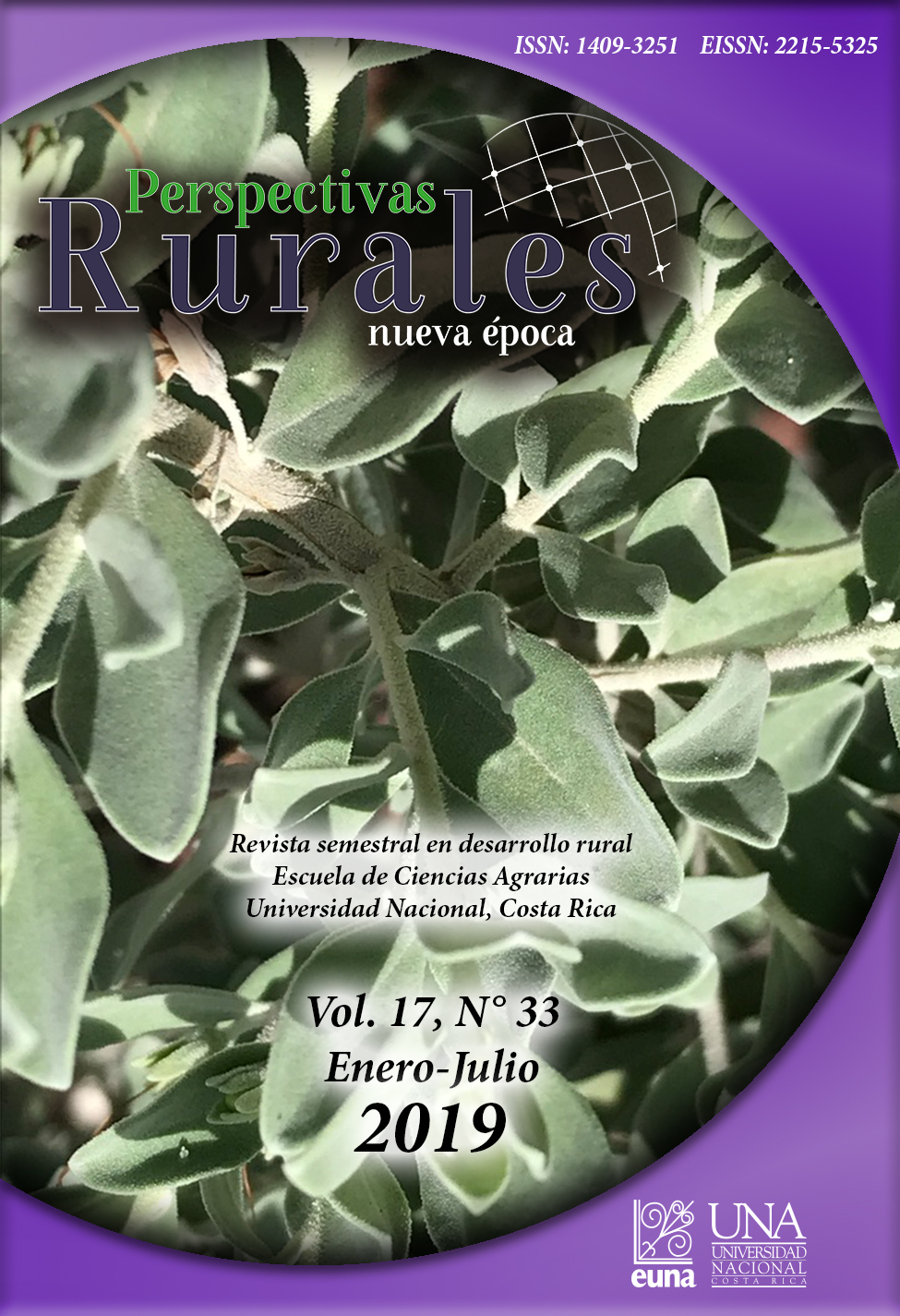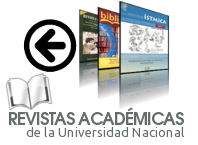Analysis of the use of ecosystem goods and services in a rural community in eastern Guatemala
DOI:
https://doi.org/10.15359/prne.17-33.5Keywords:
Biodiversity, natural capital, network analysis, hunting, ZacapaAbstract
egradation of natural ecosystems and rural landscapes contributes to reducing the natural capital of human communities by increasing their vulnerability, due, for example, to the reduction of food sources or contamination of water bodies. In this study, we characterize the ecosystem goods and services used by a rural community in the municipality of Zacapa and analyze, through network analysis, how these resources are used by a group of families in the community. As a result, the goods most commonly used by the community were water, firewood, the tree locally known as ocote (by-product of Pinus maximinoi), mint, Melipona bee honey (Melipona spp.), orange, rue (Graveolens route L.), the sun, goosefoots (Chenopodium sp.), and Sija sage (Lippia sp.). The network analysis showed low connectivity between community families regarding ecosystem goods and services. In addition, low connectivity was observed between families regarding resource use. No wild animals were reported in the diet of the families interviewed, although mammalian skins and ornaments were observed in some houses.
References
Arnell, N. W. (1999). Climate change and global water resources. Global Environmental Change, 9(SUPPL.). 10.1016/S0959-3780(99)00017-5
Barton, J. H. (1992). Biodiversity at Rio. BioScience, 42(10), 773–776. 10.2307/1311996
Bascompte, J., Jordano, P., & Olesen, J. M. (2006). Asymmetric coevolutionary networks facilitate biodiversity maintenance. Science, 312(5772), 431–433. 10.1126/science.1123412
Bersier, L. F., Banašek-Richter, C., & Cattin, M. F. (2002, September 1). Quantitative descriptors of food-web matrices. Ecology, 83, 2394–2407. 10.1890/0012-9658(2002)083[2394:QDOFWM]2.0.CO;2
Bennet, E., Peterson,G. & Gordon, L. (2009). Understanding relationships among multiple ecosystem services. Ecology Letters, 12,1394-1404.
Beveridge, L., Whitfield, S., Fraval, S., van Wijk, M., van Etten, J., Mercado, L., … Challinor, A. (2019). Experiences and Drivers of Food Insecurity in Guatemala’s Dry Corridor: Insights From the Integration of Ethnographic and Household Survey Data. Frontiers in Sustainable Food Systems, 3. 10.3389/fsufs.2019.00065
Crona, B., & Bodin, Ö. (2006). What You Know is Who You Know? Communication Patterns Among Resource Users as a Prerequisite for Co-management. Ecology and Society, 11(2). 10.5751/es-01793-110207
Csardi, G., & Nepusz, T. (2006). The igraph software package for complex network research. InterJournal Complex Systems, Complex Sy(1695), 1695. Retrieved from http://igraph.sf.net
Dormann, C. F., Fruend, J., & Gruber, B. (2018). Package ‘ bipartite .’ Visualising Bipartite Networks and Calculating Some (Ecological) Indices, 1–160. 10.1127/0941-2948/2011/105>.
Dormann, C. F., Frund, J., Bluthgen, N., & Gruber, B. (2009). Indices, Graphs and Null Models: Analyzing Bipartite Ecological Networks. The Open Ecology Journal, 2(1), 7–24. 10.2174/1874213000902010007
Dunne, J. A., Williams, R. J., & Martinez, N. D. (2002). Food-web structure and network theory: The role of connectance and size. Proceedings of the National Academy of Sciences of the United States of America, 99(20), 12917–12922. 10.1073/pnas.192407699
Forneri, C., Blaser, J., Jotzo, F., & Robledo, C. (2006). Keeping the forest for the climate’s sake: Avoiding deforestation in developing countries under the UNFCCC. Climate Policy, 6(3), 275–294. 10.1080/14693062.2006.9685602
Gotelli, N. J., & Graves, G. R. (1996). Chapter 1: Philosophy, history. In Null Models in Ecology (pp. 1–16). Smithsonian Institution Press.
Guess, G. M. (1991). Poverty and profit in Central American forest policies. Public Administration and Development, 11(6), 573–589. 10.1002/pad.4230110605
Lakerveldab, R., Lele, S., Crane, T., Fortuin, K. & Springate-Baginskid, O. 2015. The social distribution of provisioning forest ecosystem services: Evidence and insights from Odisha, India. Ecosystem services, 14, 56-66. https://doi.org/10.1016/j.ecoser.2015.04.001
Lazega, E., Wasserman, S., & Faust, K. (1995). Social Network Analysis: Methods and Applications. Revue Française de Sociologie, 36(4), 781. 10.2307/3322457
Magrin, G. O., Marengo, J. A., Boulanger, J. P., Buckeridge, M. S., Castellanos, E., Poveda, G., … Vicuña, S. (2015). Central and South America. In Climate Change 2014: Impacts, Adaptation and Vulnerability: Part B: Regional Aspects: Working Group II Contribution to the Fifth Assessment Report of the Intergovernmental Panel on Climate Change (pp. 1499–1566). 10.1017/CBO9781107415386.007
Méndez, M., & Magaña, V. (2010). Regional aspects of prolonged meteorological droughts over Mexico and central America. Journal of Climate, 23(5), 1175–1188. 10.1175/2009JCLI3080.1
Myers, N., Mittermeler, R. A., Mittermeler, C. G., Da Fonseca, G. A. B., & Kent, J. (2000). Biodiversity hotspots for conservation priorities. Nature. 10.1038/35002501
Pimentel, D. (1991). Global warming, population growth, and natural resources for food production. Society and Natural Resources, 4(4), 347–363. 10.1080/08941929109380766
R. Core Team. (2014). R Core Team (2014). R: A language and environment for statistical computing. R Foundation for Statistical Computing, Vienna, Austria. URL Http://Www.R-Project.Org/., R Foundation for Statistical Computing.
Sain, G., Loboguerrero, A. M., Corner-Dolloff, C., Lizarazo, M., Nowak, A., Martínez-Barón, D., & Andrieu, N. (2017). Costs and benefits of climate-smart agriculture: The case of the Dry Corridor in Guatemala. Agricultural Systems, 151, 163–173. 10.1016/j.agsy.2016.05.004
Santilli, M., Moutinho, P., Schwartzman, S., Nepstad, D., Curran, L., & Nobre, C. (2005). Tropical deforestation and the Kyoto protocol. Climatic Change, 71(3), 267–276. 10.1007/s10584-005-8074-6
Thow, A., Vernaccini, L., Marin Ferrer, M., & Doherty, B. (2017). Inform Global Risk Index - Results 2018. In Publications Office of the European Union. 10.2760/754353
UNFCCC. (2019). What is the Kyoto Protocol? Retrieved from United Nations Climate Change website: https://unfccc.int/process-and-meetings/the-kyoto-protocol/what-is-the-kyoto-protocol/what-is-the-kyoto-protocol
Downloads
Published
How to Cite
Issue
Section
License
![]()
Revista Perspectivas Rurales. Nueva Época se encuentra bajo una licencia Creative Commons Reconocimiento-NoComercial-CompartirIgual 4.0 Internacional License.
Creado a partir de la obra en http://www.revistas.una.ac.cr/index.php/perspectivasrurales
Los autores/as que publiquen en esta revista aceptan las siguientes condiciones:
- Los autores/as conservan los derechos de autor y ceden a la revista el derecho de la primera publicación, con el trabajo registrado con la Licencia Creative Commons Atribución-NoComercial-CompartirIgual 4.0 Internacional, que permite a terceros utilizar lo publicado siempre que mencionen la autoría del trabajo y a la primera publicación en esta revista.
- Los autores/as pueden realizar otros acuerdos contractuales independientes y adicionales para la distribución no exclusiva de la versión del artículo publicado en esta revista (p. ej., incluirlo en un repositorio institucional o publicarlo en un libro) siempre que indiquen claramente que el trabajo se publicó por primera vez en esta revista.
- Se permite y recomienda a los autores/as a publicar su trabajo en Internet (por ejemplo en páginas institucionales o personales) antes y durante el proceso de revisión y publicación, ya que puede conducir a intercambios productivos y a una mayor y más rápida difusión del trabajo publicado.






